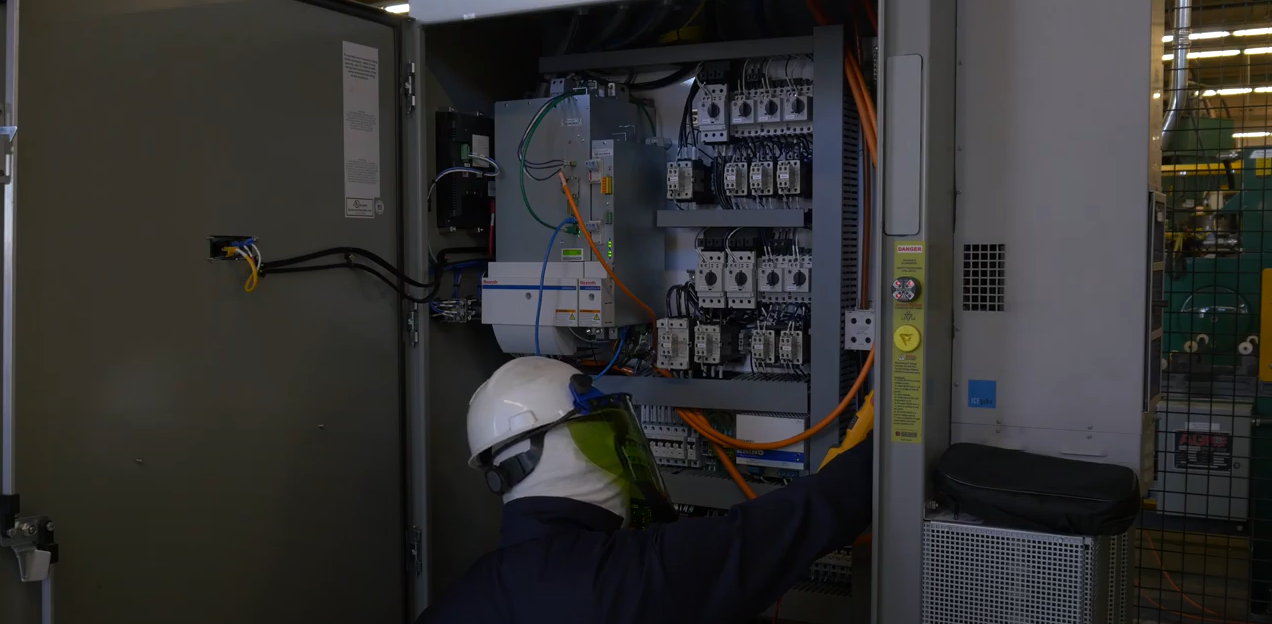An LBIES Arc Flash Assessment Contributes to Workplace Safety
As required by OSHA and the NFPA 70E, Lewis Bass’s Arc Flash Assessment Service helps your company to determine if the potential for a hazardous electrical arc flash exists in your equipment that employees work on or near when the equipment is exposed and energized.
Arc Flash Assessments are an essential part of a safe and comprehensive electrical safety program. OSHA and NFPA require employers to identify all potential electrical hazards in the workplace such as shock and Arc-Flash Hazards, reduce or eliminate the hazards, train and qualify their employees, and provide them with Personal Protective Equipment (PPE) that will protect them from all hazards.
Knowing what OSHA requires and how NFPA 70E can help meet the requirements will not only keep workers safe, but will also increase your worker productivity and overall profitability for your business.

An LBIES engineer evaluating a panel with the proper PPE

Typical arc flash warning signage in the workplace

What arc flash assessments can help to prevent
Common Misconceptions About Arc Flash Assessments
Arc Flash Misconception #1:
OSHA does not enforce NFPA 70E for Arc Flash and electrical safety compliance.
Clarification:
OSHA 1910 Subpart “S” specifically requires employers to establish an electrical safety program including safe electrical design, safe electrical
maintenance requirements, and safe work procedures for special electrical equipment.
OSHA 1910.332 requires employers to train and qualify their employees in safe work practices and standard operating procedures to reduce the hazards and increase worker safety.
Arc Flash Misconception #2:
Per IEEE 1584 — Guide for Performing Arc Flash Hazard Calculations, there is no need to assess equipment under 240 volts from a transformer rated less than 125 kVA.
Clarification:
All equipment operating at 50 volts and higher must be assessed for electrical shock and potential Arc Flash hazards per OSHA regulations and NFPA 70E
standards. IEEE 1584 helps to determine the Hazard Risk Category and PPE requirements of NFPA 70E. NFPA 70E references the IEEE 1584 calculation methods in NFPA 70E Annex D.
IEEE 1584 states, “Equipment below 240 V need not be considered unless it involves at least one 125 kVA or larger low-impedance transformer in its immediate power supply.” This statement refers to the incident energy exposure possible under these conditions as observed during testing.
The IEEE statement means that it is not necessary to calculate incident energy on equipment under 240V fed from a transformer less than 125 kVA, because the available fault current is not high enough to sustain an Arc-Flash and release significant energy.
NFPA 70E: Hierarchy of Risk Controls*
The hierarchy of risk control methods has been ubiquitous in the safety world and is in no way a new concept, but as part of NFPA 70E, the hierarchy was moved from being an informational note to the standard’s mandatory text.
The Hierarchy of Controls starts at the source, starting with the protections considered to be immune to human error and moving to the controls that are often the most feasible at any facility. Per NFPA 70E Sec. 110.3(H)(3), the six steps are as follows:
- Elimination: Removing the hazard entirely
- Substitution: Replacing a severe hazard with a less severe one
- Engineering Controls: Replacing equipment or changing the work environment to separate workers from a hazard.
- Awareness: Educating workers on the hazards and providing information on making safe decisions.
- Administrative Controls: Developing formal procedures and processes for working safely under anticipated conditions.
- Personal Protective Equipment: Equipping workers with clothing and equipment designed to reduce risk and limit the severity of injuries.
* As described in this enespro blog post from October 2018.

What Makes LBIES’s Approach to Arc Flash Assessments Different?
Our approach to Arc Flash assessments leaves nothing to chance:
- Collect all of your available system data for our engineers to review.
- Find the correct Configured Mode/Sequence of Operation.
- Determine Bolted Fault Currents.
- Determine Arc Fault Currents.
- Locate Protective Device Characteristics and duration of Arcs (Coordination).
- Document and record system voltages and classes of equipment.
- Identify Safe Working Distances from the equipment.
- Calculate and record Incident Energy for the equipment.
- Calculate and record the Flash-Protection boundary for the equipment.
- Provide a single layer one-line diagram of the portion of the power distribution system considered in the analysis.
- Finish the assessment and label all equipment included in the analysis.
Does Your Company Need an Arc Flash Assessment?
LBIES would love to be your solution-driven partner in this next step toward ensuring your company’s worker safety and compliance to OSHA standards.
To get started, please reach out to using our online contact form.
We will ask for a list of panels and equipment needing assessment and/or we will schedule a complimentary site visit to help your team identify what needs to be part of the Arc Flash Assessment project scope.



